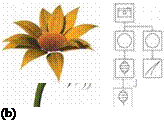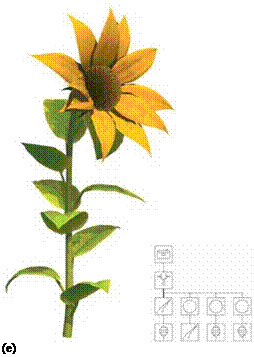For the production of plants, the components are linked by the user to form the p-graph. The user then defines the respective parameters of the components. To construct a p-graph, the components are selected from a graphical toolbox and linked to the already produced components. Three types of links are available:
■ Child link: This is a standard link. The component’s geometry is placed relative to the preceding component. The p-graph displays these links as thin lines (Fig. 6.6a).
■ Branch link: The component is multiplied as a branch of a tree component or a horn component. In all other cases it is interpreted as a child link. These links are displayed as bold lines (Fig. 6.6b).
■ ![]()
![]()

 |
Leaf link: If the father component is part of a recursion, the geometry of the child component is created only once after the recursion terminates via the recursion parameter. Thus, in the structural sense, the component is a leaf of the i-tree. These links appear as dashed lines.
In the figures following in this chapter, the directions of the lines are omitted in the p-graph, since these always point away from the root component. To display recursions, double lines are used. Additionally, in this case the first component is displayed twice in order to denote the starting and end points of the recursion in the graph.
 Chapter 6 These modifications allow for the display of the p-graph as a tree, which avoids
Chapter 6 These modifications allow for the display of the p-graph as a tree, which avoids
Rule-Based Object Production many problems, and is visually clearer. The disadvantage of the illustration
 |
 |
is that nested recursions cannot be displayed. However, since, for other reasons, they also cannot be handled by the system, they are not permitted in the p-graph.[7]
![]()
 (d)
(d)



